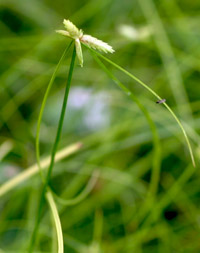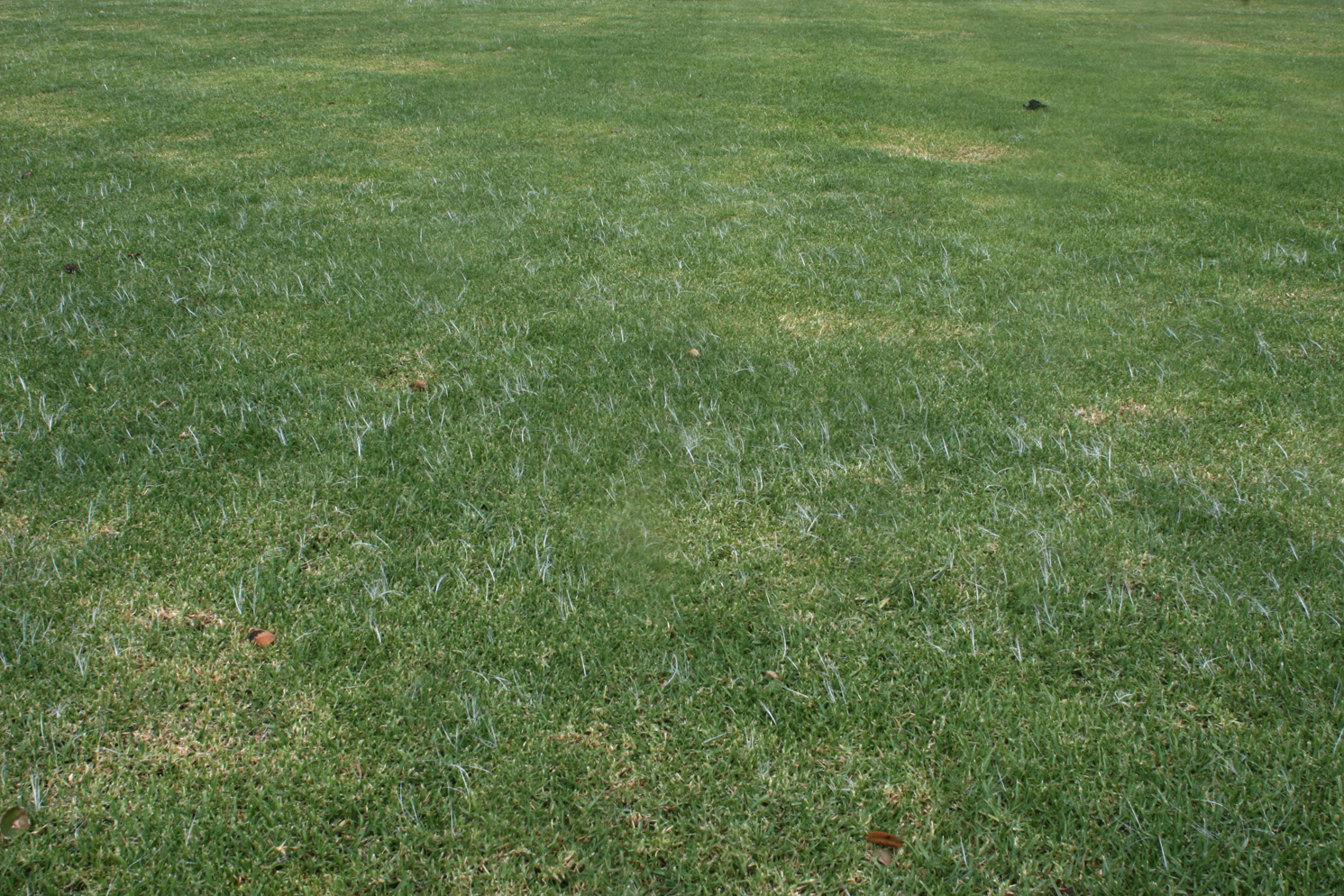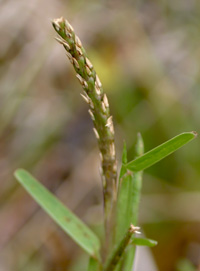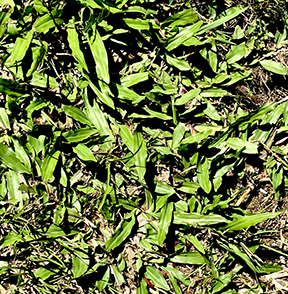|
|
|
[START OF LAWN GRASS KEY]
|
. |
|
. |
|
30a
|
( 9) 9) |
Leaf blades extremely thin, 1/16 inch (1 mm) across or less, needle-like if stiff, thread-like if arching .. .
|
|
[31]
|
|
30b
|
|
Leaf blade not as above, typically at least 1/8 inch (3 mm) across at widest point
.. .
|
|
[35]
|
|
~~~~ ~~~~~~~~~~~~~~~~~~~~~~~~~
|
|
|
31a
|
(30) |
 Leaf blades filiform (thin, thread-like, 1 mm wide or less) and arching, no more than 6 or 7 inches (15 cm) long, typically somewhat less, 3 or 4 arising at the base of a somewhat lax flowering culm. Flower head at tip of culm a cluster of 2 to 6 flattened spikelets and two or more long, filiform bracts. { growing in moist, shaded areas of a lawn, spreading by plantlets. A lawn weed. McCoy grass, mau‘u hunehune. [HAW - NAT] [FACU]
Leaf blades filiform (thin, thread-like, 1 mm wide or less) and arching, no more than 6 or 7 inches (15 cm) long, typically somewhat less, 3 or 4 arising at the base of a somewhat lax flowering culm. Flower head at tip of culm a cluster of 2 to 6 flattened spikelets and two or more long, filiform bracts. { growing in moist, shaded areas of a lawn, spreading by plantlets. A lawn weed. McCoy grass, mau‘u hunehune. [HAW - NAT] [FACU]Family CYPERACEAE (a sedge) —
Cyperus gracilis R. Br.
|
|
|
31b
|
|
Leaf blades thin, but generally rather short and stiff. Flower head without filiform bracts. Fine-textured sod-forming lawn grass
.. .
|
|
[32]
|
|
~~~~ ~~~~~~~~~~~~~~~~~~~~~~~~~
|
|
|
32a
|
(31) |
Inflorescence (flower head) a single, short spike. { Sod tight but tending to hump up. Zoysiagrass. At least 11 species of zoysiagrass are used as turfgrass, with Zoysia matrella and Z. japonica being most prominant. Also developed are interspecific crosses such as between Z. matrella and Z. japonica and Z. pacifica and Z. tenuifolia. Z. japonica varieties tend to be coarser textured. Infloresence with 3 - 12 spikelets: Z. pacifica; infloresence with 10 - 50 spikelets: Z. japonica and Z. matrella (Reynolds, 2014) .. . Hybrids of the two varieties of Zoysia grass (e.g., 'Emerald') and between Z. matrella and other Zoysia species (e.g., 'El Toro', 'Z-3', 'Z-52') are available as stolons, plugs, or sod and widely used (e.g., golf course greens).
|
(33) |
|
32b
|
|
Infloresence of multiple spikes (3 to 6, typically 4) radiating out from top of culm. { Sod flat, not tending to form humps. Bermuda grass .. .
|
(34)
|
|
~~~~ ~~~~~~~~~~~~~~~~~~~~~~~~~
|
|
|
33a
|
(32) & (51) |
Blades very narrow (< 0.5 mm) and flowering heads barely projecting above leaf blades. Mascarene grass, velvet grass, ma‘u kepani. [HAW - NAT] Syn: Z. tenuifolia. [HAW - ORN] [FAC] [GUM - IND]
Zoysia pacifica (Goudsw.) M. Hotta & Kuroki
(= Zoysia matrella var. pacifica Goudsw. of some authors)
|
|
|
33b
|
|
Blades wider (0.06-0.09 in or 1.5-2.3 mm) and flowering heads to 1.75 in (4.4 cm) long, projecting well above leaf blades. Manila grass [HAW - NAT] Japanese grass [HAW - ORN] [?GUM - NAT]
(Zoysia matrella var. matrella Merr.) |
|
|
~~~~ ~~~~~~~~~~~~~~~~~~~~~~~~~
|
|
|
34a
|
(32) |
Blades usually 2 in (5 cm) long or more and 0.1-0.15 in (2.5-4 mm) wide. Bermuda grass, mānienie. [HAW - NAT][GUM - NAT]
Cynodon dactylon (L.) Pers.
|
|
|
34b
|
|
Blades 1.75 in (mm) long or less and very narrow (0.08 in or 2 mm wide). Hybrid Bermuda; various cultivars (e.g., 'Tifdwarf'). [ORN]
Cynodon x magennisii Hurcomb
|
|
|
~~~~ ~~~~~~~~~~~~~~~~~~~~~~~~~
|
|
|
|

Figure 21C. A lawn of Kikuyu grass with anthers on white filaments extending an inch or so above the mowed surface (Waimea, Hawai‘i). Click here to download a close-up image showing the stigmas:
Fig. 4E. Kikuyu grass with stigmas.
|
|
35a
|
(30) |
Grass appearing not to ever flower, but on close examination, the spikelets are seen to be enclosed in the uppermost leaf sheath, so only filaments and/or stigmas are normally exposed (see Fig. 21C above). { forms a thick turf from runners and stolens, typically at higher elevations such as in Waimea on the Big Island and upcountry Maui. Kikuyu grass. USDA noxious weed. [HAW - NAT] Cenchrus clandestinus (Hochst. ex Choiv.) Morrone
|
|
|
35b
|
|
Grass produces flowering heads on culms that rise above at least the base of the blade although typicaly well above
|
[36] |
|
~~~~ ~~~~~~~~~~~~~~~~~~~~~~~~~
|
|
|
36a
|
(35) |
[NOTE:THREE CHOICES HERE]
Flowering head (inflorescence) consists of one to many spikes or racemes attaching laterally (if more than one) or terminally (if one) to the culm
|
[37] |
|
36b
|
|
Flowering head an open panicle: spikelets attached by short or long stalks (pedicels) to a branching culm
|
[40] |
|
36c
|
|
Flowering head an open panicle of mostly simple branches arising in whorls along the culm, each branch with a terminal cluster of two or three spikelets. Spikelets with no or short awn. Ligule a dense line of very short hairs. { Small, spreading grass appearing in lawns; common on Guam. USDA noxious weed (makes no sense). Manienie ‘ula, golden beardgrass [HAW -IND?] inifuk, palaii [GUM - IND] Chrysopogon aciculatus (Retz.) Trin.
|
|
|
~~~~ ~~~~~~~~~~~~~~~~~~~~~~~~~
|
|
|
37a
|
(36) |
Inflorescence a single spike, unbranched, rising above the turf or extending out from near the leading edge of stolons
|
[38]
|
|
37b
|
|
Racemes or spikes two or more on a culm
|
[39]
|
|
~~~~ ~~~~~~~~~~~~~~~~~~~~~~~~~
|
|
|
38a
|
(37) |

Inflorescence a thick, single spike-like axis, 1 to 3 in (3-8 cm) long with spikelets inserted in grooves. Stems thick. Leaves usually grey-green, blunt-tipped, and folded. { Extensively running grass used widely in lawns in drier areas, especially in sandy soils, forming a thick, spongy turf under good conditions. St. Augustine grass, buffalo grass, ‘aki‘aki haole. [HAW - NAT] [GUM - NAT]
Stenotaphrum secundatum (Walter) Kuntze
Figure 21D. Inflorescence of St. Augustine grass. This grass flowers infrequently. Short grey (called blue), folded leaves with rounded tips, coarse creeping stems, and spongy mat can be helpful identifying characteristics in the absence of a flower head.
|
|
|
38b
|
|
Rachis of inflorescence not thickened to prominence over spikelets, rather more typically narrow and partly hidden by spikelets. Spikelets not in grooves, but arrayed in one side of rachis. Grass not coarse. { Extensively running by stolons forming a thick, shallow-rooted sod in nearly full sun. Centipede grass, Honan grass. [HAW - ORN] [GUM - ORN]
Eremochloa ophiuroides (Munro) Hack.
|
|
|
~~~~ ~~~~~~~~~~~~~~~~~~~~~~~~~
|
|
|
39a
|
(37) |
Racemes or spikes two or more, all (or all but an uppermost pair) spaced out along the culm .. .
|
[40]
|
|
39b
|
|
Racemes or spikes more than two and arising from a common point or very close together at the top of the culm: an arrangement called digitate .. .
|
[80]
|
|
~~~~ ~~~~~~~~~~~~~~~~~~~~~~~~~
|
|
|
40a
|
(39) |
Racemes nearly always two in number (rarely three), these widely spreading .. .
|
[41]
|
|
40b
|
|
Spikelets typically three or more in number, arising close together (digitate) or not (often only the uppermost pair together on the culm) .. .
|
[43]
|
|
~~~~ ~~~~~~~~~~~~~~~~~~~~~~~~~
|
|
|
41a
|
(40) |
Spikelets ovate, flattened, only slightly longer than wide. Racemes nearly always two (only very rarely three) in number and resembling an old-fashioned on-the-set TV antenna. .. .
|
[42]
|
|
41b
|
|
Spikelets elongate, much longer than wide. Racemes usually three in number, one typically shorter, but often only two present. { A delicate, spreading, typically lanky, small grass appearing as a weed in lawns. [HAW - NAT] [GUM - IND]Digiteria radicosa (J. Presl.) Miq.
|
|
|
~~~~ ~~~~~~~~~~~~~~~~~~~~~~~~~
|
|
|
42a
|
(41) |
Racemes thin to 2.5 in (10 cm) long each, Spikelets tiny, under 0.1 in (2 mm) in length. Ligule a delicate membrane with a line of hairs. Plants spreading by wiry stolons. { Popular lawn grass in wet, windward areas. Hilo grass, mau‘u Hilo. [HAW - NAT] [GUM - NAT]Paspalum conjugatum Bergius
Be sure to confirm the disc-shape of the small spikelets, as many Digiteria (common weeds in lawns) present with just two racemes.
|
|
|
42b
|
|
Racemes coarse to 2.5 in (10 cm) long each. Spikelet broadly elliptic, plump, 2.5-3.9 mm long; rachis broad, deep purple in color. Ligule a fringe of hairs. Plants spreading by underground "rootstock" (rhizomatous). { Bahia grass. [HAW - NAT] [GUM - NAT]
See also similar Paspalum minus [HAW] with spikelets 1.9-2.3 mm in length.
|
|
~~~~ ~~~~~~~~~~~~~~~~~~~~~~~~~
|
|
|
43a
|
(40) |

Figure 21E. A. compressus lawn, showing short, wavy-margined blades with three veins.
Racemes typically three to 5 in number and only uppermost close together. The inflorescence enclosed in a sheath and emerging slowly or only partially (see Fig. 5H). Leaves short and broad with three parallel veins; leaves have a blunt, sometimes rounded tip and distinct, wavy margins(Fig. 21E). Spikelets elliptic or narrowly obovate, appressed to rachis; spikelet pedicels very short. { Small, perennial, spreading grass typically volunteering in lawns, but now widely seen as a lawn grass, dominating especially in moist and somewhat shady locations. Broad-leaved carpetgrass [HAW - NAT] [GUM - NAT]Axonopus compressus (Swartz) P. Beauv.
|
|
43b |
|
Racemes typically three or more in number. Spikelets elongate, but plant either spreading by stolons or, if clumping, then not particularly delicate. { Other species of Digitaria (known as crabgrasses) may appear as weeds in lawns; none is a "lawn" grass. see Genus Digitaria to identify these lawn weeds.
|
|